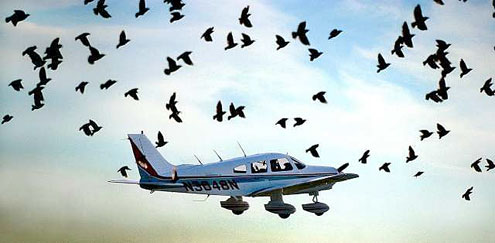One of the most unexpected things that can happen while flying is an encounter with the feathered kind. Birds are the first aviators of the skies, and as such should be respected. Bird encounters with jets have been well documented, and aircraft manufacturers have gone to great lengths in researching optimal methods of ensuring that bird strikes do not fatally affect the safety of airliners. However, have you ever considered how a bird strike could affect you in your single engine or general aviation aircraft?
While it is assumed that most bird strikes occur between ground and 2500ft, certain birds of prey, such as vultures can be found at higher altitudes. This demonstrates that birds pose a danger to all aircraft, yet, general aviation aircraft, and their pilots, are the least equipped to deal with these situations. Unlike the weather, there are few reports or methods of predicting bird activity, but a bit of common sense, and healthy respect for nature can increase your safety.
One would think that a 700kg aircraft would have the upper hand when striking a bird that is far lighter, and slower, but the laws of science apply. To understand the concept, if you have ever ridden a bicycle at a reasonable speed (say 30km/hr), and a beetle travelling in the opposite direction hits you in the face, it feels like a missile! The damaging effects of a bird and a light aircraft colliding can be so significant that it can be fatal to the aircraft, or even the pilot. The speed of the aircraft, and the size of the bird, as well as the position of the strike will determine the damage. The biggest consideration is that light aircraft are generally not constructed with the thought of withstanding the impact of a bird strike. Materials used are generally chosen for their light weight, and aerodynamic properties, not their resistance to airborne hits. So how will hitting a bird affect your aircraft?
Reported damage is mostly related to the size of the bird, with some of the worst cases being a strike which takes out the windscreen and knocking the pilot unconscious. Similarly, a big hit on a wing can be just as dangerous as this can affect the aerodynamics and therefore, the ability of the wing to produce lift. Scary thought!
Is there a way of preventing bird strikes?
Although nature still rules, I do believe that a bit of conscious thinking will save a fellow aviator. Here is what you can do:
- Be aware, especially on take-off and on approach.
- Make sure that your windscreen is clean so that you have a better chance of identifying a ‘spot’ as a bird.
- Do not be an arse (yes, you read correctly) and fly low over pans, shorelines, cliffs where birds nest.
- Be aware of minimum heights over nature reserves, and inform yourself which reserves have breeding programs for large birds, and respect these.
- As all good pilots do – check the NOTAMS for the areas you will be flying over, and please make a report of your own if you do encounter significant bird activity.
- If you do see a bird(s) headed in your direction, prepare to pull up in a controlled manner, as the natural instinct of most birds is to dive down.
- If coming in to land, especially at grassy aerodromes, it may be a good idea to do an initial runway inspection to check for ground based bird activity.
If you have hit something in flight, be sure to focus your attention primarily on flying the aircraft and land as soon as convenient to assess the damage . Be aware of where you are flying and respect the airspace of our feathered friends!





A really lovely post Essential. I really like the way you emphasise the protection of birds. I can tell you many tails of bird strikes – some leading to near disaster and very costly repairs.